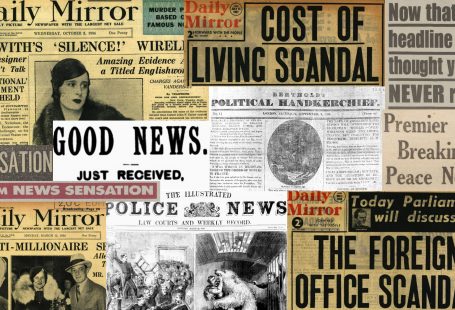Prima ballerina, choreographer, teacher and business woman, Irish born Dame Ninette de Valois was instrumental in raising the global profile of British ballet, founding the company that would become the Royal Ballet, and nurturing the talent of some of the country’s most famous dancers, including Alicia Markova and Margot Fonteyn.
In this special blog, we take a look at de Valois’ early years, her rise to prima ballerina, and her shift into production and choreography, using pages from the British Newspaper Archive.
Early Years
Born in County Wicklow, Ireland, on 6 June 1898 under the name of Edris Strannus, the Irish Independent reports how de Valois’ ‘graceful dance moves were first honed on the cold, stone floor of a farmer’s kitchen.’ When she was seven, she and her family moved away from Ireland to London, and it was then that she started to learn ballet. The Irish Independent relates how she would call it ‘fancy dancing.’
Making her first appearance on stage just two years later, it was her mother who suggested the change to her stage name of Ninette de Valois. The French sounding name was in honour of her Huguenot ancestry.
Cheltenham Looker-On | 8 August 1914
But her rise to fame, as reports The Sketch in 1950, was not an easy one, ‘as she danced to success the hard way.’
She began in London with seven child pupils, and toured the country with a group of ‘Wonder Children,’ being herself billed as the ‘Pocket Pavlova.’’
The same article relates how:
She said once: ‘I have danced the Dying Swan on every pier in the British Isles. I have also been booed off almost every music-hall stage.’ One night at the Liverpool Empire there was such pandemonium she could not hear the orchestra. ‘Why don’t you ring down the curtain?’ she shrieked in the stage manager’s ear. ‘We never ring down the curtain here,’ he riposted with dignity, ‘till they begin throwing things.’
Dancing with Diaghilev
Despite such heckling, de Valois was determined to succeed. According to the Irish Independent, by 1918 she was principle dancer in such operas as Thais, La Traviata and Aida. But this was not enough for de Valois.
In 1923 she joined famous Russian ballet impresario Sergei Diaghilev, founder of the Ballets Russes. In the early 1920s, Britain lacked an international reputation for ballet, and so dancers often had to look to companies elsewhere to further their careers. And as for de Valois, she more than furthered her career under Diaghilev.
Not only did she become a soloist in his company, she learned, according to The Sketch, what it was that could propel ‘a dancer to the heights.’ That vital ingredient was personality. The Sketch suggests British dancers were lacking that quality, and were unable to ‘express themselves on stage, probably because from birth a British child was taught never to express its emotions.’
After dancing with Diaghilev, de Valois returned to Britain, with the intent of forming her own ballet school and company.
An Indigenous British Ballet
It was to Ireland she went first, however, in 1927, where she choreographed and performed in WB Yeats’ Plays for Dancers, and according to the Irish Independent, ‘was instrumental in the establishment of the short-lived Abbey School of Ballet.’
She then returned to London, where she helped to found the Vic-Wells Ballet Company in 1931 – intent on promoting ballet and creating ‘an indigenous British ballet with its own unique style.’
The Bystander, in 1935, describes de Valois’ multiple roles as ‘ballerina, choreographer, ballet-mistress, [and] business woman:’
She is first of all the producer of the Vic-Wells company, and, as such, responsible for the dancers, designers, composers, choreography. Then it is to her that the corps de ballet owe their training, for it is from members of her dancing school that the Company has been built up. Next, she is the leading English choreographer, Job, The Haunted Ballroom, Douanes, and the newest ballet, The Rake’s Progress being her most important works. Further, she is a more than competent business woman to whom the financial success of the company is largely due.
The Bystander | 30 September 1936
Her dance school saw some famous pupils move through its doors, namely one Peggy Hookham, better known as Margot Fonteyn, who was apparently de Valois’ favourite pupil.
Madame
Largely responsible for the establishment of British ballet, Ninette de Valois was certainly a redoubtable force. The Vic-Wells Company changed its name to Sadler’s Wells Ballet, and finally, with royal approval, to the Royal Ballet in 1956. Journalist Collie Knox describes a 1950 encounter with ‘Madame:’
Miss de Valois… sat uncompromisingly behind her desk, obviously livid at being disturbed even for a moment from directing the Sadler’s Wells Ballet at Covent Garden, the Sadler’s Wells Opera Ballet, Sadler’s Wells Theatre, and the Sadler’s Wells School of Ballet.
The Woman Behind The Wells | The Sketch | 1 March 1950
Made a dame in 1951, she finally retired in 1970. Establishing a British national ballet was not her only achievement however, as she helped to found the national ballets of Canada, Turkey and Iran.
De Valois passed away aged 102 in March 2001. An article in her memory in the Irish Independent describes a particularly profound moment in which de Valois signalled her ambition to succeed, most particularly as a woman:
There was a tradition in her family that a bonfire be lit to celebrate the birth of an heir. One was built in anticipation of her birth, but was ripped down when her parents realised they had not had a son. When told the story, aged nine, she promised to light her own bonfire. And she certainly did.












